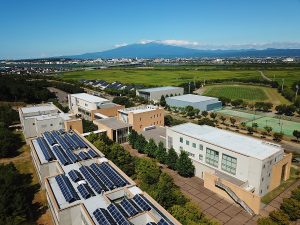During Prime Minister Suga Yoshihide’s first policy speech in the Diet on October 26 he made a bold pledge to strive for net zero emissions by 2050. But without specific details on how the goal would be realized, Japan is heading into an uncharted energy future, which is seeing renewed ambitions around restarting nuclear power plants in lieu of coal.
While Japan may have finally stepped up its vision in combating climate change, it suffers from a unique renewable energy dilemma. Its forested and mountainous topography makes finding space for wind and solar energy generation not only limited but expensive. Battery capacity is another reason behind Japan’s slow adoption of solar and wind power. Meanwhile, typhoon season in summer is intensifying as a result of global warming and these unstable weather conditions make energy generation unpredictable and susceptible to price fluctuations. Japan’s transition to clean energy is a difficult challenge that will require an infrastructure overhaul on the energy grid nationwide and technological innovation in both public and private renewable energy sectors.
Japan is the world’s fifth largest polluter and thermal energy accounts for 70 percent of its total energy generation. In fiscal year 2010, nuclear energy made up 25 percent of the country’s energy mix, but after the Fukushima triple core meltdown in 2011 all 54 nuclear reactors were taken offline for safety inspections. The nuclear accident traumatized the nation and spurred a highly motivated anti-nuclear movement. Currently, just nine nuclear reactors are in operation and in fiscal year 2018 nuclear energy was just 6 percent of Japan’s total energy use.
The appeal of nuclear power is that it can supply a vast amount of energy without emitting carbon dioxide. Accordingly, the government has plans to reactivate additional nuclear power stations in the next 10 years. Some experts say that reducing greenhouse gas emissions by 2050 cannot be realistically achieved through renewable energy alone. But there are hurdles for reactiviating nuclear power stations, such as the high costs for ensuring safety and the disposal of spent fuel and contaminated water.
With the international community turning its back on coal power and lingering public distrust over nuclear energy, Japan is desperate to expand its domestic renewable energy capacity into a stable and low cost alternative. Minister for Trade Kajiyama Hiroshi said the share of renewable energy will be lifted next year with a review of the 2018 Basic Energy Plan, which outlines a current energy mix of 22-24 percent for renewables, 20-22 percent for nuclear power, and 56 percent for fossil fuels such as oil, coal, and gas.
As the world competes to reach net carbon neutrality, Japan faces fierce competition from China and the EU, who are leading technological innovation in renewable energy. According to the International Renewable Energy Agency, China employs the highest number of people in the renewable energy sector with approximately 4.36 million people compared to 270,000 employees in Japan. China is also the world’s largest producer of solar panels. But Japan aims to expand solar power generation by 2036 through the commercialization of the Perovskite solar cell, which not only boasts a sun conversion efficiency rate of 50 percent but is also low cost and can be installed on unconventional areas such as walls and curved surfaces.
In addition, Japan hopes wind power will secure 10 million kilowatts of electricity – the equivalent of 10 nuclear power plants. Chiba and Akita prefectures have been selected as future offshore wind power sites, while plans for a wind farm are already underway in Hokkaido.
The move away from fossil fuels will depend on the mass production of large-capacity batteries, which allows for surplus electricity to be stored. Suga pledged to speed up research and development on next generation batteries, as well as experimental carbon capture and carbon recycling, where CO2 emissions can be reused for chemicals and fuel. The roll out of large-capacity batteries is expected to make up for the impact of weather fluctuations on renewable energy and eliminate the risk of power outages and price fluctuations. Next generation storage batteries will also enable electric vehicles to travel 1,000 kilometers with one charge compared to the current maximum of 500 kilometers.
Japan is also eyeing entry into the emerging hydrogen economy. Green hydrogen is a zero emissions fuel where the only byproduct is water. It’s produced by high temperature steam electrolysis in conjunction with electricity from renewable energy. The EU hailed hydrogen energy as the “rock star” of renewable energy and has predicted that hydrogen could account for 24 percent of global energy demand by 2050. In September, Airbus Europe announced plans to commercialize hydrogen-fueled aircraft by 2035 and China launched new incentives for hydrogen vehicle manufacturers to promote technological development. In Japan, Toshiba Energy, TEPCO, and Iwatani Corporation have built “the world’s biggest” joint hydrogen production plant in Fukushima. At this stage it’s able to supply electricity to 150 households for one month and will serve as a model for local energy production and consumption.
Japan’s enthusiastic goal of a carbon neutral society by 2050 won praise from the United Nations and breaks from the former Abe administration’s poor track record on carbon reduction targets – in particular, supplanting a previous target of reducing emissions by 80 percent by 2050. It also overtakes China’s pledge to be carbon neutral by 2060 and aligns closer to the EU’s zero pollution and “green recovery” package and the U.S. President-elect Joe Biden’s pledge to rejoin the Paris Climate Accord to establish a green energy economy by 2050.

































